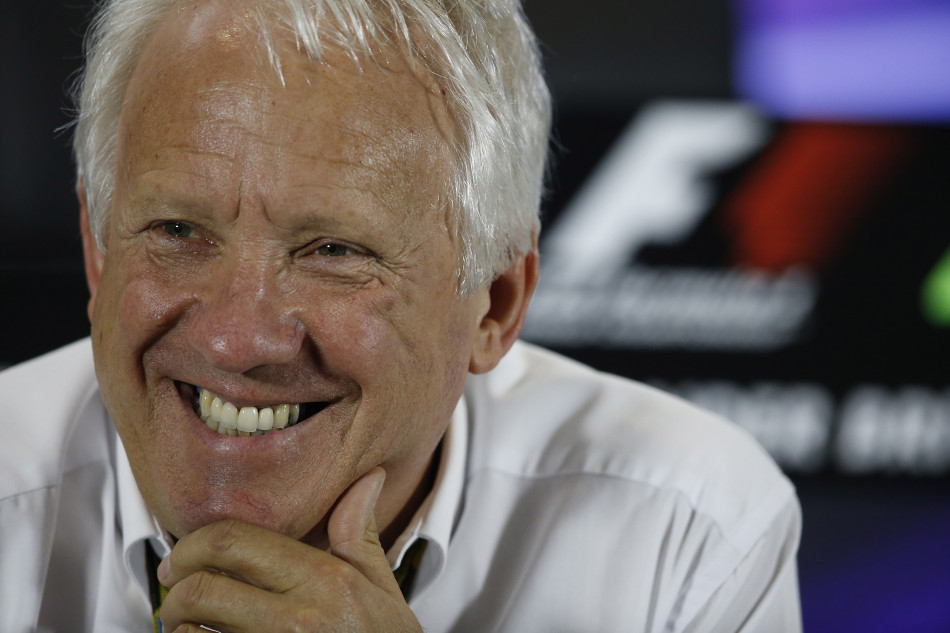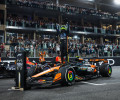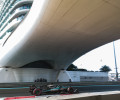FIA Race Director Charlie Whiting - Media Briefing

FIA Race Director Charlie Whiting, Media Briefing
British Grand Prix. 03.07.14
Q: (John Noble – Autosport) In Austria there was a new policy regarding driving standards. I think [this was] more of a step back from you regarding driver punishments. [However], we saw the [Sebastian] Vettel incident getting investigated. Could you clarify just exactly what the changes are and why Vettel still got investigated as I think you said beforehand it would only be in incidents where one driver was clearly to blame?
Charlie WHITING: It didn’t mean that the incident wouldn’t be investigated because you can’t establish whether you feel one driver was wholly or predominantly to blame until you have looked at it. The stewards said it was under investigation and they had a look and they deduced from that that no further action was warranted. That is the procedure.
Q: (Dieter Rencken – Racing Lines) Charlie, for two years in a row we’ve had very ugly cars. I believe that one of the WMSC regulation changes is that the aesthetics of the cars will be looked at. How will you define what is beautiful and what is ugly and how are you going to enforce it?
CW: We can’t legislate against ugly cars but what we can do is to try to get closer to what was originally intended. We’ve done that by first of all making the cross sections of the nose larger. They can’t get any smaller the further they go back, as there are minimum cross sections: 50mm back and 150mm back from the tip of the nose. They have to be a certain height and a certain width and they must be symmetrical about the car centre line.
We have also taken some measures with the crash-testing regulations in order to prevent the very soft noses, with which there was no deceleration, no energy being absorbed over the first 150mm. We want to make sure that it is the low bit that interacts, in the case of an accident, with a wheel. The cross sections should prevent the sort of designs we’ve seen this year. However, you can’t unlearn things and aerodynamics will rule, but we have arrived at what we believe to be the best solution to try to achieve the primary objective, which is safety.
Q: (Kate Walker – Crash.net) Obviously we’ve only had one race so far with the drivers freed up, in theory, to race a bit more. How do you see that working so far, what kind of feedback have you had from the drivers, do you think there is a bit more freedom on track in how they’re responding?
CW: I’ve had no feedback from drivers, but I have had lots of positive feedback from people at the initiative that has been taken.
What the initiative says is that unless the stewards feel that a driver is wholly or predominantly to blame, no further action will be warranted. Therefore, it’s still a decision of the stewards; the stewards are the ones who decide whether they think a driver was wholly to blame. Where it’s clear to everybody that there is no driver clearly to blame the matter won’t go to the stewards, it won’t go as far as summoning the drivers to explain what happened. There will simply be no further action. We’ll see how it goes. However, when this came up in the Formula One Commission, where everyone felt it was a good way to proceed, I had to point out that we usually only act on matters we are asked to take look at, so it’s up to the teams to make sure they don’t ask us to investigate small incidents as well. We all have to play out part.
Q: (Andrew Benson – BBC Sport) Can you explain the substance and intent of the titanium skid block regulation please, including whether other parts of the plank will still have other kinds of material in the skid block?
CW: To explain: the plank is the long bit of wood, the skids are bits of metal within the plank. The skids have formerly been made of a heavy metal, which has been very resistant to wear, and they put the skids around the points in the plank where thickness is measured. Planks have to start off at nominally 10mm thick and they can’t be less than 9mm thick. However, we only measure them around certain holes in the plank. So they position the skids around those holes.
This metal is extremely heavy and when pieces detach they can be extremely harmful. We saw two punctures in Spa previously because of bits of this metal that lay in a kerb and caused damage. In a worst case scenario they could fly off and hit someone.
The purpose of making them out of titanium is threefold: Firstly, it’s safer, because if they do come off they are about a third of the weight of the existing ones. Secondly, the titanium wears some 2-2.5 times more quickly than the metal currently used. Thus cars will have to be run a little bit higher to manage wear and teams won’t be able to drag them on the ground quite as much as they have in the past. The third effect is that you will see a lot more sparks, which some people think will look a little more spectacular.
Q: (Alberto Antonini – Autosprint) Two questions. First, could elaborate on the problem that slowed down Sebastian Vettel at the Austria Grand Prix because I understand it came from the standard ECU. The second question is: what led you to think that the standing restart for next year would be a sensible, convenient solution?
CW: The bug in the standard ECU software was exactly that. [Sebastian selected] the overtake mode – which gives him a different map. However, the software refused to accept the map, deciding that it wasn’t a legal map. In fact, it was a legal map. However, when the ECU deemed it to be illegal the result was he had no power at all – 0 Nm.
Two things will take [the ECU] out of that mode. The first is a timeout, which is 60 seconds. The second is braking. Having selected the overtake mode on a straight when the driver then brakes at the end of the straight for a corner the ECU will revert to the previous map.
However, because Sebastian was going uphill, he didn’t have to brake and therefore he had to wait for the 60-second timeout, after which power came back. It was unfortunate. No one wants to see a bug in software but it does happen from time to time. I think I’m right in saying it’s the first time that anything has so overtly affected a car since 2008 when the standard ECU was introduced.
The other question was about the safety car standing restarts. What must be remembered is that this was a suggestion from a team. I put it to the other teams and they all agreed that it was a very good idea. In fact, I’ve rarely seen such enthusiasm for a new idea.
The idea is based on the rationale that the start is the most exciting part of the race in the view of most people and if you can have another one it would also be extremely exciting. This idea was embraced by all the teams at team manager level. It was then discussed by the Formula One Strategy Group, which unanimously felt it was a very good way to go to improve the spectacle of Formula One. It then went to the Formula One Commission and finally to the World Council. They also felt it was a good thing for Formula One. The teams were 100 per cent behind it.
I have heard some drivers express concerns but I think we can allay those fears. Their first concern was in regard to fairness. They felt that a race leader was more likely to lose his lead from a standing start than he is from a rolling start. Equally, however, if you are in second place you might actually like the idea of being able to take the lead, which you probably wouldn’t do with a rolling start.
There was also some concern about taking a standing start on worn tyres. However, until you get to the point where there is a standing start, the safety car procedure will be exactly the same as before. As happens now any driver on worn tyres is likely to pit. If you’ve just made a pit stop then you probably wouldn’t do it, but anyone else will, as they will want to take the advantage of what is effectively a free stop. I think the chances of any driver resuming the race from a standing start on very badly worn tyres is very low. Those are the only concerns I’ve heard so far.
Q: (Michael Schmidt – Auto Moto und Sport) You said that for the FIA safety is a priority so how can the FIA be happy with standing restarts which potentially add risk?
CW: If you say that a second standing start is dangerous it presupposes that the first one is as well. Of course, you are more likely, statistically, to have incidents during a standing start than at any other time in the race but no driver wants that to happen and no driver will cause that to happen. I don’t believe that there is any added risk, personally.
Q: (Gary Anderson - FOM) With the safety car, the biggest time loss seems to be getting the lapped cars unlapped. Is there anything that can be done about that or do you think that’s not important?
CW: We have to go back to the reason for having it and that is to provide clean restarts. My personal view is that it is a price worth paying. If we look at this year’s Bahrain Grand Prix, I don’t think we would have had such a good end to that race or the final bit of that race wouldn’t have been as good if there had been four or five lapped cars between the cars on the lead lap. I think that was vindication of that rule.
Q: [Marc Surer – Sky Germany] [With safety cars standing starts] Why don’t you just put up the red flag? What about the cars going around, if there is an accident, they have to remove the car, it’s dangerous for the workers.
CW: I think the Safety Car has worked extremely well in a number of circumstances and I think if you stop the race every time you were going to put the Safety Car out if would be a bit of a nuisance really.
You mentioned how long it takes to un-lap the cars…
CW: That bit will happen exactly the same as it does now. The only change will be, instead of the last lap under the Safety Car being a rolling start it will be like the formation lap. They’ll come back to the grid… and go. There will be no people going onto the grid again. It will just be literally like a formation lap. I think the Safety Car is an extremely good tool and has been for many years and I wouldn’t want to lose it. Also there are many occasions where we will use the Safety Car – when it’s wet, for example. Under those circumstances we’re very unlikely to allow a standing start. So, I think we can deal with it. If the situation demands the race to be stopped, we will stop it.
Q: (Jonathan Noble – Autosport) Charlie, are there any more plans for another sparks test or another megaphone test on this on-going noise issue?
CW: No plans for any sparks tests. Noise is something that we’re still working on. A solution that has been tested on a dyno is to split the exhaust. We’ve [currently] got one tailpipe in the centre of the car where all the exhaust gasses come out. We did this purposefully to minimise the effect of the exhaust gasses [on aerodynamics] because, as you know, we’ve had lots of problems with the rules on exhausts.
What they’ve found is that by splitting that exhaust, you do get more noise. It would seem to work, especially with megaphones, be they round or rectangular, to some extent. The next step is to look at the feasibility of doing it. If you’re going to put a megaphone or two on the back of a car, there’s a lot of interaction between wing pillars, rear wings, monkey seat wings, rear impact structures, rear lights. All those sorts of things would have to be re-engineered, potentially, to accommodate two exhaust pipes instead of one. It’s not a straightforward job. And I think the next step it to assess whether or no everyone feels this is a worthwhile thing to do. That’s where we are.
Q: (Dieter Rencken – Racing Lines) Charlie, we had a tyre blanket ban and then it was rescinded. Pirelli said they hadn’t been consulted about the effect of the ban and it’s rescindment. We’ve had the Safety Car and the drivers say they haven’t been consulted. Pirelli say they haven’t been consulted about the effects. Are we consulting everybody affected before decisions are taken – or how does it work?
CW: I think it’s fair to say that the teams are consulted. The teams pay their drivers and they are employees of the teams. I don’t think we would necessarily consult the drivers. We keep them informed about what’s going on but it’s really up to the teams to make sure that, if they need to engage their drivers in this decision-making process, to actually do so. Going on to the tyre blankets themselves, the proposal was initially to save money by not having blankets but then it began to emerge that it was very difficult for the tyre company to make tyres that could be used safely without blankets. It was rescinded because Pirelli said they would provide the blankets. Any money that was going to be saved by banning them was going to be made up, so there was no need to do it. Pirelli were present during that conversation in the Formula One Commission.
Q: (Michael Schmidt – Auto Motor und Sport) I think if you use up all your tokens it’s about 48% of the engine you are allowed to modify over the winter. What happens if there is a change of ownership? And if the new owner renames or gives a new badge to the engine. Is that a bypass to build a complete new engine?
CW: I don’t know. We haven’t been faced with that question yet. We have been asked something similar in the past. What would happen if Renault became Nissan, for example? I think we would have to take a view on whether that really was a new engine or just a Renault with a different badge on it in order to do something that they wouldn’t otherwise be allowed to do. It’s something that we’ll have to do on a case-by-case basis.
Q: (Craig Scarborough – ScarbsF1) Charlie, one of the big rules this year was the fuel flow limitation. Obviously there was lots of noise back in Melbourne about problems with it. Are the FIA and the teams now happy with the accuracy and the reliability of the flow-meter? – and will there be any changes for next year? Will there be another flow-meter homologated?
CW: I think with any new system there are bound to be teething problems and there were a few problems at the first race but it’s got a great deal better. Here we’re introducing new firmware on two sensors per team which we hope will overcome the offset problem which we think is being caused by cold fuel being put into the car – specifically in qualifying where the car comes in and they add fuel that changes the temperature considerably. Hopefully the firmware should resolve that problem.
Is there a plan to introduce a new one next year? We know of one company who is attempting to develop a sensor. If it meets our requirement specification then we can homologate it and the teams will have a choice.
Q: (Mike Doodson – Auto Action) Charlie, [Red Bull Racing] is rather noisily unhappy with the performance of its engines. Is there any leeway in the regs, any at all which will allow [Renault] to catch up to Mercedes-Benz?
CW: Only within the rules. They can change things for reliability reasons and for cost-saving and safety reasons. Those are the only things they can do in the sealed perimeter of the engine.
Q: (Silvia Arias – Parabrisas) Charlie, tell me, has anything been decided about the double points in the last race. Is there anything new about next year?
CW: There’s nothing new, no. As far as we’re all concerned it’s what’s written in the rules and that’s what will happen this year and will happen until it gets changed. Like every rule it stays until people decide they want to change it.
Q: (Jonathan Noble – Autosport) Charlie, any more progress on MADMAT?
CW: MADMAT is still under discussion with the teams. Just a couple of days ago I gave them a cost estimation. We’re leaving it to the teams now to decide if they want to implement it. I think it’s really good. It’s amazing how effective it is for so relatively little money. I think it’s one of those quite simple inventions that will be used extensively.
Q: (Gary Anderson – FOM) Charlie, the engine regulations over the last few years with the V8, obviously the homologation was a very good thing but currently with what appears to be an offset in performance of the Mercedes to Renault and Ferrari, do you think that regulation is the right thing for Formula One at the moment?
CW: The fundamental difference between the previous homologation regulations and this one is that the previous one was an engine freeze for six or seven years and this is you locking your performance for one year. So I’m sure we’ll see some significant changes of design between this year and next. There are about 45 different bits of engine you can change for next year. You can’t change them all, you can only change 48% of those but that’s a fairly significant amount of things you can change. I’m sure they’re all working madly on that. But, as I say, the biggest difference is that the performance is only locked in for one year. Apart from the reliability, of course.
Q: (Craig Scarborough – ScarbsF1) Another one of the rule changes for this year, speaking on the power units is the limit of five of the different elements per season. We’re obviously only eight races in. Lots of drivers are on their fourth element, particularly on control electronics, are any of the teams asking for dispensation on any of these things? And, will next year’s reduction down to four engines per season seem somewhat draconian after the reliability this year?
CW: The first thing we need to remember is that four engines was always the goal. There was always going to be four engines per driver per season. That was the original intention and the five engines was a concession for the first year. There was never any doubt it was going to be four engines. It’s not a draconian change from five down to four. It’s just following the original intention.
Secondly, yes, some drivers are in a bit of trouble and will start to incur penalties, probably two thirds of the way through the season. It’s a shame, we don’t want to see this any more than anyone else does but those who appear to be better prepared for the start of the season are in good shape. That’s just the way it goes, unfortunately. The control electronics has been a surprise but I’m sure the second year will be a whole different matter.
Q: (Stuart Codling – F1 Racing) Charlie, can I ask why the FIA is continuing to play along with the business of noise and researching noisier solutions? The energy-efficient formula was an FIA project, it was pushed through by the President and, since noise is energy, to make more noise you’re potentially making the cars less efficient. Is this making the efficiency formula a nonsense?
CW: From what I understand it won’t make the engines any less efficient. It’s just a matter of handling the exhaust gasses in a different way. Whether or not we need to go that route, I certainly don’t hear quite so much noise – if I may use that word – going around about it. So we’ll see. If that’s what everybody wants we’ll have to do what we can to achieve it.
Q: (Mark Fogarty – Fairfax Media) Charlie, we’ve been going for 35 minutes. One word that hasn’t really come up is ‘fans’. You’ve consulted everyone it appears for all these changes and ones going back – except the fans. Most of these decisions, I think it’s fair to say, have proved very unpopular with the fans. Why isn’t anyone consulting them and asking their opinion before the fact rather than waiting for them to… well, waiting for the howls of protest.
CW: Of course we listen to what fans say. We wouldn’t be doing all this work on engine noise if we didn’t – but this has to be tempered by the wishes of those involved in the sport and who should probably know a little more about the reasoning behind rules. There was a bit of a fuss about the double points but it was done, I believe, for perfectly good reasons. The engine noise, we knew it would always be quieter. But is that a bad thing? Do you think it’s a bad thing? I certainly don’t.
I think we should be focusing more on the racing because the racing’s been very good.
Q: (Haorin Zhou – Formula One Express) Bernie said in an interview about two months earlier, he said about the double points that it was already decided, it’s the same for everyone so we shouldn’t complain about it. What’s interesting is that afterwards he said perhaps it’s not fair. Do you have any reaction on that?
CW: Absolutely none. What Bernie says is his business. I’m not going to comment on what Bernie says.
Q: (Adam Cooper – Autoweek) In Canada, the stewards took a decision on the Massa/Perez collision without talking to the drivers and it was reopened in Austria where I think the stewards actually felt that Massa was equally to blame but they were loathe to change the penalty. In retrospect, does the FIA accept that the Canadian stewards were wrong and are their procedures in place to make sure that doesn’t happen again and that drivers are always spoken to?
CW: I don’t think it’s essential that the FIA puts measures into place to make sure the drivers are always heard. The reason they weren’t heard in Canada was that we had two team representatives who were willing and able to represent their drivers at the time because we were told the drivers could be as much as three hours before they came back from hospital, assuming they weren’t kept in. The decision was taken to deal with the situation there and then. If the teams had said we don’t want to do this without the driver here then maybe the stewards would have done differently.
I believe what they did was perfectly acceptable. They [Force India] wished to have a right to review and the stewards in Austria decided there was a new element in that first of all Sergio’s verbal evidence hadn't been heard and I believe they also wanted to show the team telemetry. The stewards reheard it and they reached the same verdict. If you are alluding to them wanting to reach a different verdict but didn’t feel they could well that’s clearly not the case.

 Facebook
Facebook Twitter
Twitter






